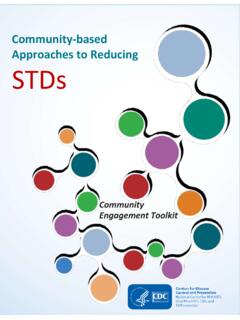Transcription of Impact Fees: Practical Guide for Calculation and ...
1 - 1 - Impact Fees: Practical Guide For Calculation And Implementation by Dennis H. Ross, Fellow, ASCE, and Scott Ian Thorpe, RCS Principal Abstract: The use of development Impact fees (DIFs) to finance public facilities necessary to accommodate new growth is a concept that has gained acceptance in recent years. California and Florida are considered by many to be the leading areas for the development of theory, Practical models, and legislation for determining growth-related costs and calculating Impact - fees for new construction. Two methods of Calculation of Impact fees are discussed: inductive and deductive. A total of 22 potential Impact fees for public facilities have been identified, including the conventional water, sewer, and street Impact fees.
2 Other potential Impact fees include public safety facilities (police and fire), library, public art, and day-care facilities. The consequences of not using Impact fees to offset the cost of providing adequate public facilities for new growth are far-reaching. Often the full effects of growth are not felt, or recognized, by the community for many years. The community may simply wake up one day to discover that they need to improve a street or intersection to alleviate congestion. This article was originally presented at the September 9-11, 1991, ASCE Successful Land Management II: Managing and Paying for Growth Conference, held at San Diego, CA, and was printed in the September 1992 issue of the Journal of Urban Planning and Development. Revenue & Cost Specialists (RCS) (714) 992-9020 RCS Principals have been helping public agencies with their financial planning since 1975 - 2 -Background and Introduction The use of development Impact fees (DIFs) to finance public facilities necessary to accommodate new growth is a concept that has gained acceptance in recent years.
3 California and Florida are considered by many to be the leading areas for the development of theory, Practical models, and legislation for determining growth-related costs and calculating Impact fees for new construction. In spite of the general acceptance of DIFs, many public officials, developers, and the general populace still do not understand the basis for Impact fees. There is a need for a Practical discussion of what types of facilities can be financed with Impact fees and how to calculate the fees. Philosophical discussions on the need for Impact fees and the effect on the economy of the community may continue indefinitely. However, the rationale for charging Impact fees is based on the premise that new development should pay the costs associated with growth.
4 Conversely, the existing residents should only bear the costs of improving existing services. Historical Perspective Impact Fees - Why Now? Impact fees are not a new issue; they have been used since the 1920's, as evidenced by the department of Commerce's Standard Planning Enabling Act enacted in 1922. (Lurz et al. 1990). Impact fees were first used to manage growth and urban sprawl. Impact fees have also been used for many years in utilities and enterprise funds in the form of connection fees, system development charges, or buy-in fees. The resurgence of Impact fees is caused by several factors working in concert to provide new sources of financing to provide public facilities associated with growth.
5 The revival of Impact fees as a form of growth control has also led to increased use of the fees according to Liberty Township, Illinois, supervisor F. T. "Mike" Graham (Lurz 1989). The taxpayer revolt of the 1970s, led by California's Proposition 13, has been credited with (or been responsible for, depending on your perspective) the increase in fees charged by public agencies. The decline in property taxes available for public projects has resulted in the agencies looking for alternative sources of revenues. There have also been numerous changes in the profile of capital-project spending over the past years. Federal spending on capital projects has decreased significantly in the past 10 years.
6 In 1981, the federal government supplied 43% of the capital for public-works projects. Eight years later, that figure had dropped to 27% (Lurz et al. 1990), a 37% reduction in federal spending. - 3 -Changes in technology have contributed to the increased sophistication of public-works projects. With this new sophistication comes added costs that have eroded the financing ability of public agencies. Changes in environmental costs of public projects have further strained the budgets of public agencies. These costs come in the form of increased regulation, mitigation expenses, and the most elusive cost -- time. The public agency can no longer simply march out in an open field and build a road or sewer line.
7 The mention of environmental costs is neither an endorsement nor criticism of the trend -- the point is that costs have swelled due to increased environmental consciousness. Increased demands from the citizens living in the community have, without doubt, resulted in the increased cost associated with public projects. Especially in urban areas, narrow roads and thoroughfares without curbs and sidewalks that were acceptable in the 1950s are no longer acceptable in the 1990s. The American population today is more educated, more sophisticated and more likely to express desires (and demands) for better public facilities to elected officials than at any time in the past. A shift in public policy regarding the responsibility for providing the infrastructure for growth (implying economic growth) has shifted from the community at large to those benefiting from the growth according to Paul Barru, a Denver builder (Lurz et al.)
8 1990). These points lead to the reality that public projects are more expensive today than they were in the past -- all of this without even starting to consider normal inflation of project costs. Philosophy of Impact Fees The premise on which Impact fees are based is that development should pay for the cost of providing the facilities necessary to accommodate growth (Recht 1988). The cost of projects needed to support growth are financed with Impact fees based on some measurement of a development's Impact on future needs. Impact fees are not intended to be used for operational expenses or to pay for capital improvements to correct an existing deficiency or shortfall. Legal Framework Several states have passed statewide legislation that affects the ability of public agencies to levy Impact fees.
9 The following are some of the most noteworthy. California. AB 1600 (Cortese), which became effective on January 1, 1989, regulates the way that Impact fees are imposed on development projects. The agency imposing the fee must (1) Identify the purpose of the fee; (2) identify the use to which the fee is to be put, including - 4 -identifying the public facilities to be financed; (3) show a reasonable relationship (nexus) between the fee's use and the type of development project; (4) show the reasonable relationship between the public facility to be constructed and the type of development; and (5) account for and spend the fees collected only for the purposes and projects specifically used in calculating the fee.
10 Florida. The Growth Management Act of 1985 requires local agencies to maintain adequate service levels for public facilities and prohibits approval of development that would cause a reduction in service level. The act also requires the local government to provide public facilities that are consistent with the community's land-use plan. The act does not specifically allow Impact fees, since the courts have ruled that the authority to levy such fees is a function of the Florida Constitution. Illinois. A single-paragraph bill was adopted by the legislature in 1987 that allows collection of transportation Impact fees (Lurz 1989). The bill was so written that it affects only two counties (DuPage and Lake), due to their population.





